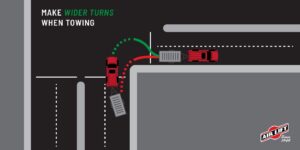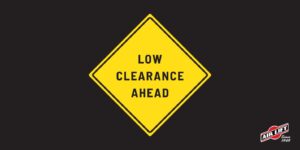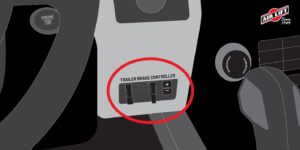Air Lift’s Towing on the Road Guide
Air Lift’s Towing on the Road Guide
Sponsored by Air Lift

If your customers are towing vehicles to or from your shop, here are some helpful reminders from Air Lift to pass along that will help each vehicle arrive safely.
Towing a trailer is a practical and valuable skill to have, but it’s one that requires a lot of practice, preparation and caution. A trailer’s added weight, length and handling characteristics will present new obstacles and variables to consider, so it is important to develop a new set of skills and safe driving practices.
Here are some things to consider in order to tow safely, regardless of whether you’re brand new to towing or a seasoned hauler.
Load Your Trailer Properly

The way you load your trailer has a huge impact on how it behaves on the road. If you put too much weight at the back of your rig, it will cause the trailer to sway back and forth and will quickly spin your trailer around … and your vehicle with it. This phenomenon, aptly named “trailer sway,” is one of the greatest risks that haulers face when towing a trailer.
To pack safely, place most (about 60%) of your trailer’s contents in the front half of your trailer and evenly distribute the weight on both sides of the trailer as best you can. Be sure to secure the contents of your trailer to prevent anything from sliding around in transit.
Make Wider Turns

When you tow a trailer behind you, you increase the overall length your vehicle must travel to make the turn and clear your now-elongated wheelbase. If you cut the turn too tight, your trailer will likely hit the curb or take someone’s mailbox with it.
Give Yourself More Room to Change Lanes
Your vehicle and trailer’s new overall length will provide a few challenges for your driving habits, including how much room you need to change lanes. Give yourself more time and space than you think to safely clear other vehicles when switching lanes with a trailer attached.
Pro Tip: Oftentimes, truck drivers or other experienced towers will flash their lights at you from the lane you are trying to merge to, indicating that you are clear to merge. Don’t mistake the flashing lights as an upset driver; they want to help!
Give Yourself More Room to Stop
Trailers add a significant amount of weight to your vehicle; the more weight you have, the longer your stopping distance will be. This also means you should pay extra attention to what drivers are doing ahead of you so you can stop as quickly and safely as possible.
Know Your Trailer’s Height
It’s imperative to know the overall height of your trailer. If your trailer is taller than your truck, commit your trailer’s exact height to memory so you know whether you can clear bridges and other overhead structures. Give yourself some headroom, too; even if you think you’ll just barely fit, it’s probably better to turn around and take another route than test that theory. The bridge always wins.
Be Wary of Low Overhead Structures

Restaurant drive-thrus, parking garages, gas stations and low-hanging trees are even more common hazards for haulers than bridges. Knowing your trailer’s height can help navigate these structures, but if you must ask yourself if you’ll fit under or through something, the answer will almost always be no.
Drive in the Slow Lane on the Highway
Trailer sway can also happen when your trailer reaches a certain speed over what it’s designed to travel at. This can quickly lead to speed wobble and may spin your trailer if it is not corrected immediately. To minimize this risk, drive in the rightmost or slowest lane and maintain a speed of 55 miles per hour or below. It’s the law in most states anyway.
This also helps if you must pull onto the shoulder for a tire blowout or load adjustment.
Pay Attention to Your Downhill Speed
It’s easy to lose track of your speed when going downhill, but the consequences can easily become catastrophic when pulling a trailer. You should already be aware of how excess speed can cause trailer sway, so it is important to take hills as cautiously as possible.
When driving downhill while towing a trailer, slow down to below the speed you intend to go before you reach the decline, then downshift and engine brake as much as possible down the grade. Do not ride your brakes, as they can overheat quickly, which will reduce their effectiveness.
Adjust Your Trailer Brakes According to Your Load if Needed

When towing heavy loads, your trailer’s brakes need to work harder to be effective, so you need to adjust the braking force to be stronger to accommodate the higher weight. After the load is taken off, you need to readjust your trailer’s brakes or they’ll lock up.
Some trailer brakes can be controlled electronically, while others need to be adjusted manually. Consult your trailer’s owner’s manual to learn how to operate your specific model’s brakes and when to adjust them.
Before You Depart…
Some of these may seem obvious but driving safely while towing a trailer requires much more planning and thinking, many more precautions and a different driving style than you might be used to. While we’re on the topic of obvious, be sure to keep up with your trailer’s maintenance by checking its tire pressure and that its lights are in working order. If you tick all of these boxes, it will all but ensure that you and your trailer get to your destination in one piece.